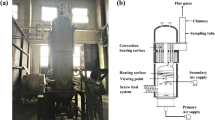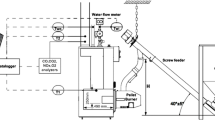Abstract
In the rural areas of China, using biomass boiler as an auxiliary heat source for district heating will be a promising way. In this paper, an experimental study on the performance of a 500-kW biomass fixed bed boiler under low-load operating conditions (15% ~ 40% of nominal load) was carried out. The results showed that low-load operation had no significant influence on the steady combustion of biomass boiler. For pollutants-discharged concentration, the overall emission concentration of NOx was maintained at about 300 mg/m3, in which NO2 accounted for a relatively large proportion compared with nominal load. NO2 accounted for up to 63% of NOx at 15% of nominal load. In these cases, NO2 had a very strong correlation with CO (Spearman = 0.867). Moreover, the impact of low-load operation on boiler efficiency was studied. The results showed that the operating conditions with boiler efficiency above 50% accounted for 44%, of which the highest efficiency was 55%.
Similar content being viewed by others
Data availability
The datasets generated during and/or analyzed during the current study are available from the corresponding author on reasonable request.
References
Böhler L, Görtler G, Krail J, Kozek M (2019) Carbon monoxide emission models for small-scale biomass combustion of wooden pellets. Appl Energy 254. https://doi.org/10.1016/j.apenergy.2019.113668
Lamberg H, Sippula O, Tissari J, Jokiniemi J (2011) Effects of air staging and load on fine-particle and gaseous emissions from a small-scale pellet boiler. Energy Fuels 25:4952–4960. https://doi.org/10.1021/ef2010578
Gu X, Cheng M, Zhang X, Zeng Y (2021) The pollutant discharge improvement by introducing HHO gas into biomass boiler. Int J Hydrogen Energy 46:23292–23300. https://doi.org/10.1016/j.ijhydene.2021.04.133
Mousavi SM, Fatehi H, Bai XS (2021) Numerical study of the combustion and application of SNCR for NO reduction in a lab-scale biomass boiler. Fuel 293. https://doi.org/10.1016/j.fuel.2021.120154
International Energy Agency (IEA) (2012) World Energy Outlook. http://www.worldenergyoutlook.org/weo2012/. Accessed 01.11.15
Soltero VM, Chacartegui R, Ortiz C, Velázquez R (2018) Potential of biomass district heating systems in rural areas. Energy 156:132–143. https://doi.org/10.1016/j.energy.2018.05.051
Quirion-Blais O, Malladi KT, Sowlati T, Gao E, Mui C (2019) Analysis of feedstock requirement for the expansion of a biomass-fed district heating system considering daily variations in heat demand and biomass quality. Energy Convers Manag 187:554–564. https://doi.org/10.1016/j.enconman.2019.03.036
Nunes LJR, Matias JCO, Catalão JPS (2017) Biomass in the generation of electricity in Portugal: a review. Renew Sustain Energy Rev 71:373–378. https://doi.org/10.1016/j.rser.2016.12.067
Deboni TL, Simioni FJ, Brand MA, Lopes GP (2019) Evolution of the quality of forest biomass for energy generation in a cogeneration plant. Renew Energy 135:1291–1302. https://doi.org/10.1016/j.renene.2018.09.039
Cao Y, Dhahad HA, Hussen HM, Anqi AE, Farouk N, Issakhov A (2022) Development and tri-objective optimization of a novel biomass to power and hydrogen plant: a comparison of fueling with biomass gasification or biomass digestion. Energy 238. https://doi.org/10.1016/j.energy.2021.122010
Gunukula S, Daigneault A, Boateng AA, Mullen CA, DeSisto WJ, Wheeler MC (2019) Influence of upstream, distributed biomass-densifying technologies on the economics of biofuel production. Fuel 249:326–333. https://doi.org/10.1016/j.fuel.2019.03.079
Nowak K, Rabczak S (2021) Co-combustion of biomass with coal in grate water boilers at low load boiler operation. Energies 14. https://doi.org/10.3390/en14092520
Liu H, Chaney J, Li J, Sun C (2013) Control of NOx emissions of a domestic/small-scale biomass pellet boiler by air staging. Fuel 103:792–798. https://doi.org/10.1016/j.fuel.2012.10.028
Proto AR, Palma A, Paris E, Papandrea SF, Vincenti B, Carnevale M, Guerriero E, Bonofiglio R, Gallucci F (2021) Assessment of wood chip combustion and emission behavior of different agricultural biomasses. Fuel 289. https://doi.org/10.1016/j.fuel.2020.119758
Robert Mack DK, Schön C, Hartmann H (2019) Combustion behavior and slagging tendencies of kaolin additivated agricultural pellets and of wood-straw pellet blends in a small-scale boiler. Biomass Bioenerg 125:52–60. https://doi.org/10.1016/j.biombioe.2019.04.003
Li PW, Chyang CS (2020) A comprehensive study on NOx emission and fuel nitrogen conversion of solid biomass in bubbling fluidized beds under staged combustion. J Energy Inst 93:324–334. https://doi.org/10.1016/j.joei.2019.02.007
Caposciutti G, Barontini F, Antonelli M, Tognotti L, Desideri U (2018) Experimental investigation on the air excess and air displacement influence on early stage and complete combustion gaseous emissions of a small scale fixed bed biomass boiler. Appl Energy 216:576–587. https://doi.org/10.1016/j.apenergy.2018.02.125
Karlström O, Vainio E, Engblom M, Brink A, Hupa M (2022) Effect of air staging on NOx emissions in biomass combustion in a bubbling fluidized bed. Fuel 330. https://doi.org/10.1016/j.fuel.2022.125565
Archan G, Scharler R, Pölzer L, Buchmayr M, Sommersacher P, Hochenauer C, Gruber J, Anca-Couce A (2021) Detailed NOX precursor measurements within the reduction zone of a novel small-scale fuel flexible biomass combustion technology. Fuel 302. https://doi.org/10.1016/j.fuel.2021.121073
Hong F, Chen J, Wang R, Long D, Yu H, Gao M (2021) Realization and performance evaluation for long-term low-load operation of a CFB boiler unit. Energy 214. https://doi.org/10.1016/j.energy.2020.118877
Li S, Chen Z, He E, Jiang B, Li Z, Wang Q (2017) Combustion characteristics and NOx formation of a retrofitted low-volatile coal-fired 330 MW utility boiler under various loads with deep-air-staging. Appl Therm Eng 110:223–233. https://doi.org/10.1016/j.applthermaleng.2016.08.159
Sun Y, Xu C, **n T, Xu G, Yang Y (2019) A comprehensive analysis of a thermal energy storage concept based on low-rank coal pre-drying for reducing the minimum load of coal-fired power plants. Appl Therm Eng 156:77–90. https://doi.org/10.1016/j.applthermaleng.2019.04.049
Ndibe C, Maier J, Scheffknecht G (2015) Combustion, cofiring and emissions characteristics of torrefied biomass in a drop tube reactor. Biomass Bioenerg 79:105–115. https://doi.org/10.1016/j.biombioe.2015.05.010
Wang Q, Liu K, Wang S (2022) Effect of porosity on ignition and burning behavior of cellulose materials. Fuel 322. https://doi.org/10.1016/j.fuel.2022.124158
Achaw OW, Afriyie JK (2014) Effects of changes in the operating conditions on the stack gas temperature and stability of biomass-fueled boilers. Chem Eng Commun 202:971–981. https://doi.org/10.1080/00986445.2014.886199
Jiang Y, Lee BH, Oh DH, Jeon CH (2021) Optimization of operating conditions to achieve combustion stability and reduce NOx emission at half-load for a 550-MW tangentially fired pulverized coal boiler. Fuel 306. https://doi.org/10.1016/j.fuel.2021.121727
König M, Eisinger K, Hartmann I, Müller M (2018) Combined removal of particulate matter and nitrogen oxides from the exhaust gas of small-scale biomass combustion. Biomass Convers Biorefin 9:201–212. https://doi.org/10.1007/s13399-018-0303-0
Cornette JFP, Coppieters T, Lepaumier H, Blondeau J, Bram S (2021) Particulate matter emission reduction in small- and medium-scale biomass boilers equipped with flue gas condensers: Field measurements. Biomass Bioenerg 148. https://doi.org/10.1016/j.biombioe.2021.106056
Archan G, Anca-Couce A, Buchmayr M, Hochenauer C, Gruber J, Scharler R (2021) Experimental evaluation of primary measures for NOX and dust emission reduction in a novel 200 kW multi-fuel biomass boiler. Renew Energy 170:1186–1196. https://doi.org/10.1016/j.renene.2021.02.055
García R, Pizarro C, Lavín AG, Bueno JL (2014) Spanish biofuels heating value estimation. Part II: proximate analysis data. Fuel 117:1139–1147. https://doi.org/10.1016/j.fuel.2013.08.049
Houshfar E, Skreiberg Ø, Løvås T, Todorović D, Sørum L (2011) Effect of excess air ratio and temperature on NOx emission from grate combustion of biomass in the staged air combustion scenario. Energy Fuels 25:4643–4654. https://doi.org/10.1021/ef200714d
Ranzi E (2016) Solid reaction mechanisms: thermochemical reactions of solid fuels. Reference module in chemistry, molecular sciences and chemical engineering. https://doi.org/10.1016/B978-0-12-409547-2.11539-2
Zhong BJ, Roslyakov PV (1996) Study on prompt NOx emission in boilers. J Therm Sci 5:143–147
Zhou A, Xu H, Xu M, Yu W, Li Z, Yang W (2020) Numerical investigation of biomass co-combustion with methane for NOx reduction. Energy 194. https://doi.org/10.1016/j.energy.2019.116868
Andrés Anca-Coucea PS, Evicb N, Mehrabianb R, Scharlera R (2018) Experiments and modelling of NOx precursors release (NH3 and HCN) in fixed-bed biomass combustion conditions. Fuel 222:529–573. https://doi.org/10.1016/j.fuel.2018.03.003
Petrocelli D, Lezzi AM (2014) CO and NO emissions from pellet stoves: an experimental study. J Phys Conf Ser 501. https://doi.org/10.1088/1742-6596/501/1/012036
Rabaçal M, Fernandes U, Costa M (2013) Combustion and emission characteristics of a domestic boiler fired with pellets of pine, industrial wood wastes and peach stones. Renew Energy 51:220–226. https://doi.org/10.1016/j.renene.2012.09.020
Tomasz H, Anna M, Joanna C, Mościcki K (2012) Negative effects of biomass combustion and co-combustion boilers. Environ Prot Eng 38:25–33
Ca W, Wang P, Du Y, Che D (2019) Experimental study on effects of combustion atmosphere and coal char on NO2 reduction under oxy-fuel condition. J Energy Inst 92:1023–1033. https://doi.org/10.1016/j.joei.2018.07.004
Bala-Litwiniak A, Zajemska M (2020) Computational and experimental study of pine and sunflower husk pellet combustion and co-combustion with oats in domestic boiler. Renew Energy 162:151–159. https://doi.org/10.1016/j.renene.2020.07.139
Malle C, Aho M, Hämäläinen J, Rouan JP, Richard JR (1997) Formation of NO, NO2, and N2O from Gardanne lignite and its char under pressurized conditions. Energy Fuels 11:792–800
Garcia-Garcia (1999) NO, reduction by potassium-containing coal briquettes. Effect of NOP concentration. Fuel Energy 13:499–505
Phiri Z, Everson RC, Neomagus HWJP, Wood BJ (2017) The effect of acid demineralising bituminous coals and de-ashing the respective chars on nitrogen functional forms. J Anal Appl Pyrol 125:127–135. https://doi.org/10.1016/j.jaap.2017.04.009
Qin C, Wu X, Huang Y, ** W (2020) The research on the influence of boiler operating parameters on thermal efficiency. 2020 6th International Conference on Energy, Environment and Materials Science. https://doi.org/10.1088/1755-1315/585/1/012113
Funding
This work was financially supported by the National Key Research and Development Program of China (Grant No. 2020YFD1100302).
Author information
Authors and Affiliations
Contributions
Ke Ji: writing—original draft, methodology, investigation, validation, data curation. Jianxiang Guo: conceptualization, formal analysis, supervision, writing—review and editing. Xuejun Bi: conceptualization, formal analysis, supervision, writing—review and editing. Zhengchang Yu: methodology, software. Chenggong Si: methodology, software. Shengjun Hou: formal analysis, writing—review and editing. **aolu Zhou: methodology, software. Xu Dong: writing—original draft, methodology.
Corresponding author
Ethics declarations
Ethics approval
The study was approved by the University’ Ethics Committee and all participants provided written informed consent prior to the experiments.
Conflict of interest
The authors declare no competing interests.
Additional information
Publisher's note
Springer Nature remains neutral with regard to jurisdictional claims in published maps and institutional affiliations.
Rights and permissions
Springer Nature or its licensor holds exclusive rights to this article under a publishing agreement with the author(s) or other rightsholder(s); author self-archiving of the accepted manuscript version of this article is solely governed by the terms of such publishing agreement and applicable law.
About this article
Cite this article
Ji, K., Guo, J., Bi, X. et al. Effects of low-load operation on biomass boiler performance: combustion stability, pollutant emission, and boiler efficiency. Biomass Conv. Bioref. (2022). https://doi.org/10.1007/s13399-022-03355-7
Received:
Revised:
Accepted:
Published:
DOI: https://doi.org/10.1007/s13399-022-03355-7












